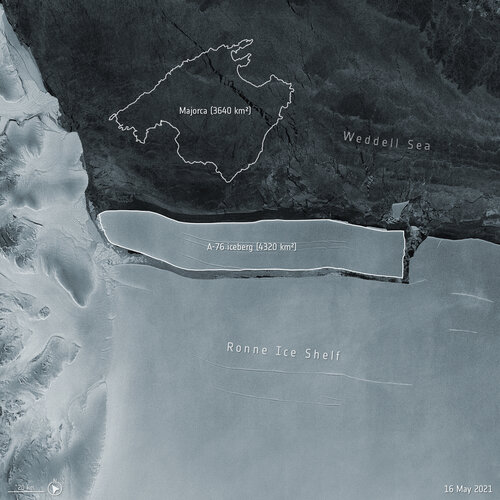An enormous iceberg has calved from the western side of the Ronne Ice Shelf, lying in the Weddell Sea, in Antarctica. The iceberg, dubbed A-76, measures around 4320 sq km in size – currently making it the largest berg in the world.
Spotted in recent images captured by the Copernicus Sentinel-1 mission, the iceberg is around 170 km in length and 25 km wide, and is slightly larger than the Spanish island of Majorca.
The enormity of the berg makes it the largest in the world, snatching first place from the A-32A iceberg (approximately 3880 sq km in size) which is also located in the Weddell Sea. In comparison, the A-74 iceberg that broke off the Brunt Ice Shelf in February earlier this year, was only 1270 sq km.
The iceberg was spotted by the British Antarctic Survey and confirmed from the US National Ice Center using Copernicus Sentinel-1 imagery. The Sentinel-1 mission consists of two polar-orbiting satellites that rely on C-band synthetic aperture radar imaging, returning data regardless of whether it is day or night, allowing us year-round viewing of remote regions like Antarctica.
Icebergs are traditionally named from the Antarctic quadrant in which they were originally sighted, then a sequential number, then, if the iceberg breaks, a sequential letter.



 Image:
An enormous iceberg has calved from the western side of the Ronne Ice Shelf, in the Weddell Sea, in Antarctica. The iceberg, dubbed A-76, measures around 4320 sq km in size and is currently the largest berg in the world.
Image:
An enormous iceberg has calved from the western side of the Ronne Ice Shelf, in the Weddell Sea, in Antarctica. The iceberg, dubbed A-76, measures around 4320 sq km in size and is currently the largest berg in the world.